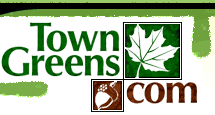Before Durham was settled, it was known as Coginching, or the Great Swamp, because it was primarily marsh land surrounded by rocky hills and generally unsuitable for farming. In the seventeenth century, portions of it had been granted to individuals in the Connecticut Colony as a reward for distinguished service in military or civic affairs. These people did not live in the area, residing in either Hartford or Guilford.
In 1699, the Guilford group petitioned the General Court to locate the center of town to the south of where it now exists. A favorable reply was received, but the larger group in Hartford was concerned about protecting their property interests to the north. The court reversed their decision after hearing from the Hartford proprietors. The town was laid out in its present axial pattern along the "Great Street," as Main Street was first known, because it was a higher strip of ground surrounded by swamp. In a town meeting on February 16, 1702, Meeting House Place (today's green) was set out reaching from the minister's lot on the north to Samuel Camp's land on the south.
The first meetinghouse was erected in 1709 on what now is the burying ground; it was the highest point on the ridge. The second meetinghouse was completed in 1737. It was built on the northeast corner of the present green. Originally the common was used as a grazing area, a place for militia exercise, and it gradually became the focus of the community around which the location of the town's religious, civic and educational buildings have been located since it was established.
The Old Center School, now the site of the local historical society, was built in 1774 and still stands on its original location just to the northwest of the green. South of the schoolhouse is the Congregational Church (1849) now used as the Town Hall and a Sabbath Day House (moved to the site in 1984). To the west behind and to the south (beside) the church is an old burying ground. The green is also the site of the Durham Public Library (1901) and the Grange Hall (originally the Methodist Episcopal Church, 1826).
It is presently a public gathering place and the site of the Durham Fair, Memorial Day events, the town Christmas Tree, and concerts. It also serves a commemorative function.
The Durham Town Green is the focal point of the community where the civic activities of the town have taken place since it was established. As well as relating visually to the green, the surrounding buildings relate to it historically and functionally. The result is one of Connecticut's finest 19th-century historic landscapes.






![]()